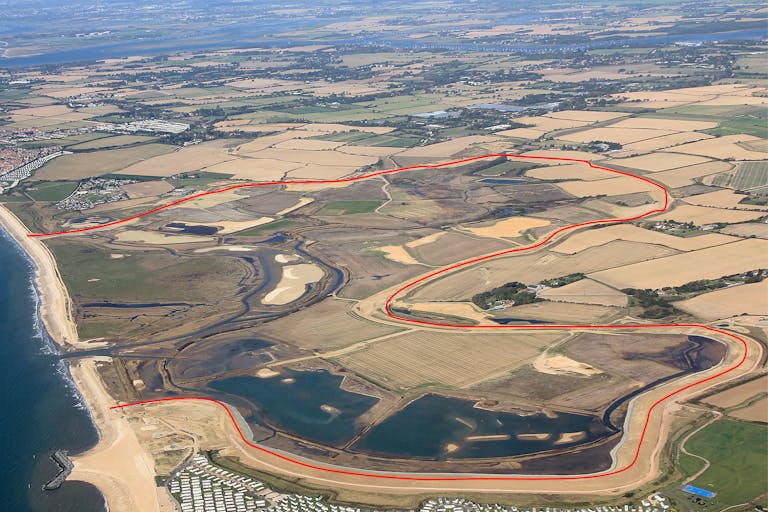To the west of Selsey lies a magical nature reserve overhung by huge skies and filled with the sound of soaring birdlife. The striking landscape of Medmerry feels like something out of a Dicken’s novel, a marshy wilderness carved by centuries of coastal erosion.
However, Medmerry Nature Reserve was created just a few years ago, the culmination of pioneering work started by two female local residents.
Medmerry was Europe’s largest coastal realignment scheme when it was opened in 2013, forging a radical new approach to coastal protection. By constructing a 7km new flood embankment on higher ground further inland and breaching the existing shingle banks, the scheme has produced more sustainable coastal protection whilst creating 183 hectares of new intertidal habitat, including mudflat, saltmarsh and transitional grassland.
The whole area, and beyond, is now an oasis for birds and other wildlife, surrounded by recreational footpaths, bridle and cycle ways with long distance views of the South Downs and the sea.
Medmerry attracts visitors from all over the world, as well as British school children who now cover it in their Geography GCSE and A level syllabi.
Medmerry has also won more than 16 major engineering, community engagement and conservation awards including the Prime Minister’s Best Building and was showcased at the IUCN (International Union of the Conservation of Nature) World Conservation Congress in Hawaii.
The new nature reserve is now a cherished part of Selsey’s unique environment.
Just how Medmerry became one of the south coast’s most important habitat sites and an exemplar of climate change adaptation is a story of two women’s dogged determination.
In 1997 when local residents Carolyn Cobbold and Renee Santema questioned the long-term sustainability of defending the peninsula’s coastline with a shingle bank constantly shored up by mechanical diggers, no one really took them seriously at first. While one had an engineering degree and a decade of researching climate change and risk management behind her, the other was a Dutch born spatial planner who understood the importance of coastal and water management in long term planning.
After raising awareness of the situation by hosting several community meetings in village halls across the Manhood Peninsula, the two friends decided to seek some outside help to convince the local authorities and the Environment Agency of the need for a longer-term solution. If they wouldn’t listen to two local residents, perhaps they would listen to Dutch experts!
After fund raising £10,000 to cover travel and accommodation expenses, they invited 30 senior Dutch and British experts in planning, coastal engineering and ecology to come to the Manhood Peninsula to help local residents and authorities confront climate change positively.
All delegates to the 2001 brainstorming workshop attended free of charge, working for five full days, from eight in the morning until late at night, in mixed disciplinary groups, devising different future plans for the peninsula. Members of the public and councillors joined them at the end of each day to hear the blue-sky thoughts of the visitors and to ask questions and make observations.
At the end of the process Carolyn and Renee produced a book, Going Dutch on the Manhood Peninsula, describing the variety of possible options the experts had come up with, from turning Selsey into an island, to building lake houses, growing saline resistant crops, creating a peninsula-wide cycle network and even banning cars.
While the ideas were varied and ambitious, there was one issue on which all delegates agreed. Letting the sea in between Selsey and Bracklesham was the most sustainable, affordable and practical solution to rising sea levels, increased wave heights and storminess. Moreover, they argued, a managed realignment of the coast presented an opportunity to create acres of valuable wetland habitat, which would be great for wildlife, recreation, tourism and the local economy. A win, win situation.
The double win became a treble win when the Medmerry realignment scheme was used as compensatory habitat creation for wetlands lost because of the expansion of Associated British Ports’ container docks in Southampton. As a result, the £28 million costs of the scheme were borne by the Associated British Ports, a move which saved taxpayer funds, boosted Southampton’s economy and helped Chichester’s economy, environment and coastal defences!
When the Environment Agency announced six years later in partnership with the RSPB that it planned to allow the sea inland as Going Dutch had outlined, many residents still needed convincing. Carolyn and Renee organised a second workshop, Going Dutch II persuading the Dutch experts to return (free of charge) to stress-test the Environmental Agency’s plans and to address locals’ concerns.
Now, more than 20 years after Carolyn and Renee began their campaign to create a more resilient coast, RSPB Medmerry is delighting locals and visitors of all kinds, including skylarks, avocet, lapwing, Brent geese, wheatears, swallows, redshanks, corn buntings, yellow hammers, owls, nightjars, merlins, peregrines, goldfinch, linnets, water voles, deer, dragonflies, dolphins and smooth hound sharks!



